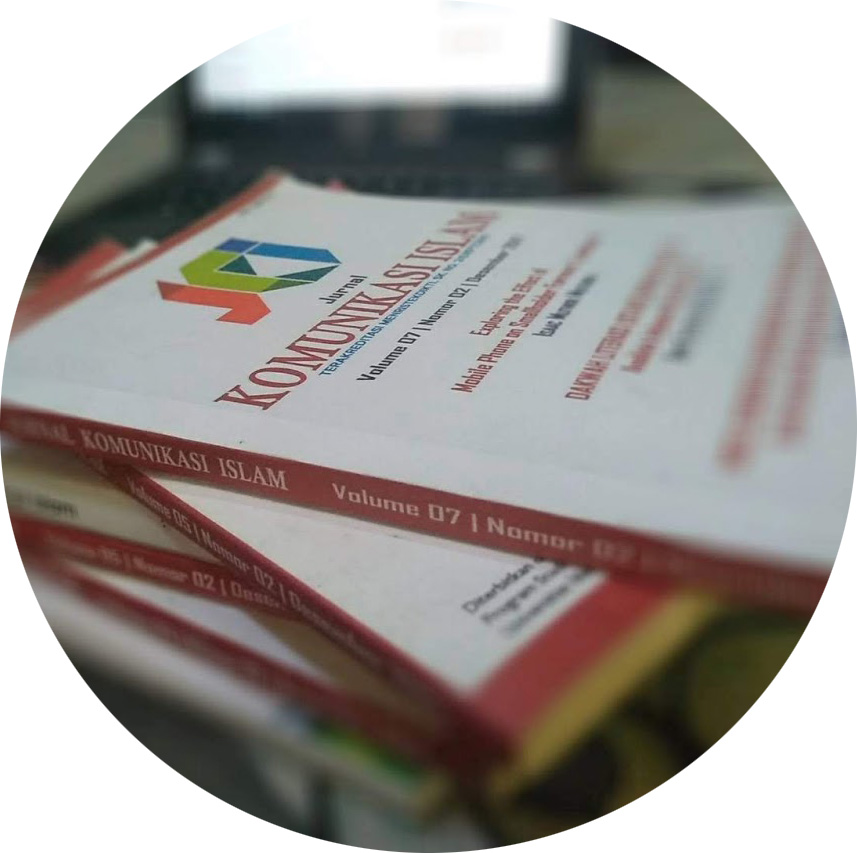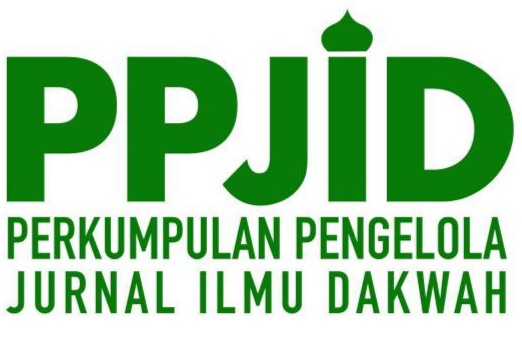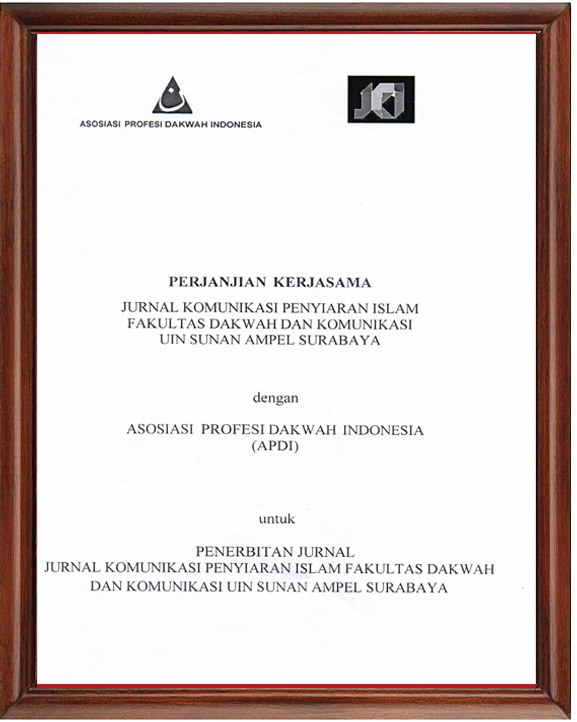Reconceptualising the Elements of Islamic Propagation: Religious Response and Adaptation to New Media
DOI:
https://doi.org/10.15642/jki.2020.10.2.198-216Keywords:
Reconceptualisation, digital da’wah, cyber culture, elements of da'wahAbstract
This paper aims to examine the fundamental concepts of da'wah in response to new media culture. Using a qualitative research for conceptual design, this study has found that the proliferation of cyber religious proselytizing leads the elements of da'wah have become ever-widening concepts. The concept of da’i, for instance, has experienced the reconceptualisation that not only refers to person who conveys Islamic teachings through religious sermon (khutbah), but also denotes to a creative content provider for da’wah purposes in the internet. Additionally, the power of preaching in the new media lies in the quality of message, that is, good, comprehensive and argumentative. Similarly, redefinition of the concepts ma'du, feedback, and other da'wah elements occur as response to digital media culture.
Downloads
References
Antweiler, K.R. (2008). Virtual religion: An Approach to a Religious and Ritual Topography of Second Life. Online-Heidelberg Journal of Religions on the Internet. 3 (1), 174-211.
Baraybar-Fernández, A., Martín, S.A., & García, R.R.. .(2020). Religion and Social Media: Communication Strategies by the Spanish Episcopal Conference. Religions, 11(5), 239-251. Retrieved from https://doi.org/10.3390/rel11050239.
Bakti, A.F. (2005). Islam and Family Planning. Leiden-Jakarta: INIS. 2004.
Bakti, A.F. (2013). Raising public consciousness about the importance of freedom of expression in a democratic society and on enhancing the quality of life of the ordinary citizen: The case of Indonesia,” The Journal of Development Communication, 24 (1), 1-15.
Berker, M., & Brooks. K. (1998). Knowing Audiences Judge Dredd: Its Friends, Fans, and Foes. Luton: University of Luton Press.
Brasher, B.E. (2001). Give Me That Online Religion. San Francisco: Jassey Bass Inc.
Branston, G., & Stafford.R. (2010). The Media Student’s Book. New York: Routledge.
Al-Bayanuny, M.A. (1995). Al-Madkhal Ila ‘Ilm al-Da’wah. Beirut: Muassasah Risalah.
Castells, M. (2009). Comunicación y Poder. Madrid: Alianza Editorial.
Cheong, P., Ess, C. (2012). Religion 2.0? Relational and Hybridizing Pathways in Religion, Social Media and Culture, in Cheong, P., Fischer-Nielsen, P., Gelfgren, S. and Ess, C., (eds.), Digital Religion, Social Media and Culture: Perspectives, Practices, Futures, p 34-56. New York: Peter Lang.
Cheong, P.H. (2017). The vitality of new media and religion: ommunicative perspectives, practices, and changing authority in spiritual organization. New Media & Society. (19), 25-33.
Campbell, H.A. (2010). When Religion Meets New Media. London: Routledge.
Campbell, H.A. (2013). Digital Religion. Understanding Religious Practice in New Media Worlds. London and New York: Routledge.
Campbell, H.A., & Vitullo. A. (2016). Assessing changes in the study of religious communities in digital religion studies. Church, Communication and Culture (1), 73-89.
Dawson, L.L., & Cowan, D. E (2004). Religion Online: Finding Faith on the Net. New York: Routledge.
Everett, A., & Caldwel.J.T. (2013). New Media Theories and Pratices of Digitextuality. London: Routletge.
Fenton, N. (2010). New Media, Old News Journalism and Democracy in Digital Age. London: Sage.
Ghulusy, A.A. (1987). al-Da’wah al-Islâmiyayah, Ush?luha wa Washâiliha. Kairo: Dâr Al-Kitab Al-Mishri.
Green, N., & Haddon. L. ( 2009). Mobile Communications: An Introduction to New Media. New York: Berg.
Gray, T. (2019). Teaching from the Tent: Muslim Women’s Leadership in Digital Religion. Thesis. University of St. Thomas, Saint Paul, MN: USA.
Gershon, Rd. (2016). Digital Media and Innovation. Management and Design. Strategies in Communication. London: Sage.
Helland, C. (2018). Virtual Religion: A Case Study of Virtual Tibet. Oxford Handbooks Online: Oxford University Press.
Hoover, S. (2006). Religion in the Media Age. New York: Routledge
Hills, M. (2002). Fan Culture. London: Routledge.
Jenkins, H. (2000). Reception theory and audience research: the Mystery of the Vampire’s Kiss, in Christine Gledhill and Linda Williams (eds), Reinventing Films Studies. London: Arnold.
Lewis, J. (2001). Constructing Public Opinion: How Political Elits Do What They Like and Why We Seem to Go Along with It. New York: Columbia University Press.
Mowlana, H. (2007). Theoretical perspectives on Islam and communication. China Media Research. 3 (4), 23-33. Retrieved from http://www.chinamediaresearch.net).
Moral, A.M., & Colmenero.R. (2015). Iglesia y Primer Franquismo a Través del Cine (1939–1959). Alcalá de Henares: Servicio de Publicaciones de la Universidad de Alcalá.
Negroponte, N. (1995). Being Digital. New York: Knopf.
Natsir, M. (1978). Fiqhud Dakwah. Jakarta: Dewan Dakwah Islamiyah Indonesia.
Natsir, M (1975). Kalimat Hak itu lebih tajam dari Pedang. Majalah Suara Masjid, 11 (3). 24-25.
Parna, K. (2010). Believing in the Net. Leiden University Press.
Pierre, L. (1997). Cyberculture. Paris: Editions Odile Jacob.
Poster, M. (1995). The Second Media Age. Cambrigde: Polity.
Qaradhawy, Y. (1996). Thaqafah al-Da’iyyah. Qahirah: Maktabah Wahbah.
Quthb, S. (1973). Da’wah Al-Islâm. Beirut: Dâr Al-Kitab Al-’Arab.
Rahman, F. (2011). Matinya Sang Dai: Otonomisasi Pesan-Pesan Keagamaan di_ Dunia@Maya. Tesis. UIN Syarif Hidayatullah: Jakarta. Retriviewed from http://repository.uinjkt.ac.id/dspace/handle/123456789/6261
Rheingold, H. (1994). The Virtual Community. London: Secker and Warburg.
Soukup, C. (2006). Computer-mediated communication as a virtual third place: Building oldenburg’s great good places on the World Wide Web. New Media and Society (8), 421-440.
Sohirin, M. (2008). Islamic Da’wah: Theory and Practice. Kuala Lumpur: IIUM Press.
Steemers, J. (2001). Broadcasting is Dead. Long Live Digital Choice, in H. Mackay dan T. O’Sulliban (eds), The Medi Reader: Continuity and Tranformatin. London: Sage.
Thayer, L. (1968). Communication and Communication System, in Organization, Management, and Interpersonal Relations. Homewood, III: Richard Irwing, Inc.
Turkle, S. (1995). Life on the Screen: Identity in the Age of Internet. New York: Simon adn Schuster.
Valentini, C. (2015). Is using social media good for the public relations profession? a critical reflection. Public Relations Review. (41), 170-77.
Zaedan, A.K. (2002). Ushul al-Da’wah. Beirut: Muassasah Risalah.
Downloads
Published
How to Cite
Issue
Section
License
Copyright (c) 2020 Adeni Adeni, Andi Faisal Bakti

This work is licensed under a Creative Commons Attribution-ShareAlike 4.0 International License.













